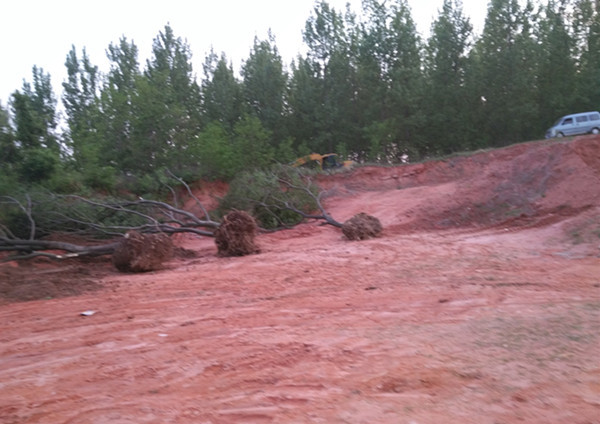Battling rampant logging in Anhui
By Ma Chenguang (chinadaily.com.cn) Updated: 2015-04-28 17:04
 |
|
Big trees lie at the foot of Chuzhou's renowned Daheng Mountain, with excavators at the backdrop. |
CHUZHOU: When Yan Ming, chief of Chuzhou Municipal Bureau of Tourism, took us to the foot of the city's Daheng Mountain for a near-dusk tour something caught his attention; some big trees were lying nearby.
After telling another colleague to lead us to climb the mountain bordering Nanqiao District and Dingyuan County, he took out his mobile phone and told us: "You go ahead. I'll check if these logs are illegally chopped down."
At 234 meters above sea, Daheng Mountain has a radius of 15 square kilometers and is known for its brilliant crimson Danxia landform. Its rich forestry is under the jurisdiction of a State-owned farm.
He phoned Wu Shengzhi, chief of Chuzhou Municipal Bureau of Forestry, inquiring if the bureau had issued certificates for these trees to be felled. Wu told Yan he'll check.
Yan then reached Zhai Yucheng, chief of Chihe Township, and Tong Xubing, Party chief of Foxiao Township, to see whether they knew of such felling, as the mountain is close to both townships in Dingyuan.
As he phoned the officials the drivers of nearby lorries, ready to transport the logs, left, making Yan even more suspicious. Later, however, the three officials showed the loggers did have felling and transport certificates for these precious hackberries, or nettle trees.
"I love trees and hate illegal logging," Yan said, as he rejoined us on the trip. He noted that as Chuzhou has an average forestry coverage of 20.4 percent city-wide, every resident should value the trees and battle illegal logging, which results in destruction of virgin forests and soil erosion, hampering water flow and bringing droughts and floods.
Historically, Anhui in eastern China, was known for its luxuriant forests, green mountain slopes and clear rivers, with forests covering 60 percent of areas in the western Dabie Mountains and 64 percent of areas in southern mountainous regions.
However, with rampant felling since 1949, forest coverage shrank remarkably. In the Dabie Mountains' area, the rate declined from 60 percent to 20.4 percent, while the rate in southern mountainous regions dropped from 64 percent to 42 percent, promoting the provincial government to launch a drive for a greener Anhui. Stringent measures were introduced to ban illegal logging.
In Jinzhai County located in the Dabie Mountains, illegal loggers targeted the trees (some 70 percent in coverage). Those tree cutters, 90 percent local farmers who have a low awareness of national forestry laws, dodged government supervision and sometimes bribed checkpoint enforcement officers, transporting the fallen trees to other areas for quick cash.
As the Forest Law stipulates in Article 32 any tree cutters must apply for a government license, violators are subject to criminal charges. In Jinzhai, some 30 loggers are charged each year.
According to Tang Dongqiang from Feidong County of Hefei City, 11 people involved in two related illegal logging cases in the county were prosecuted.
But in Taihu County under Anqing City, violators went unpunished last November in Xincang Township by dodging government checks and cutting trees on a 1.3-hectare area.
Conservationists Zeng Hui and Huang Lingling in Hefei suggested more measures to rid the province of rampant logging, including enhanced law awareness, developing the local economy to make farmers richer, simplifying warrant approval procedures and rectifying law enforcement teams to forbid bribed certificate-approval and check-release.











